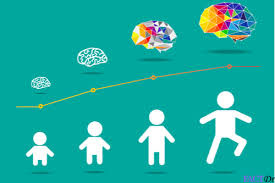Definition of growth and development
Growth- refers to changes in size or quantity, i.e., physical changes that can be measured.
Development- refers to changes in quality.
Areas of Development
Let us now define areas of development. Although we live as an integrated person, we separate the different dimensions of development for the purpose of scientific study. The various developments that take place in the life of an individual can be classified as – physical development, motor development, sensory development, cognitive development, language development, social, emotional and personal development.
Physical development- refers to the physical changes in the size, structure and proportion of the parts of the body that take place since conception.
Motor development- refers to control over body movements which result in increasing co-ordination between various parts of the body. Physical growth makes the body grow, whereas, it is motor development which results in smooth, controlled and effective body movements. The control over movements is brought about by control over the movement of the muscles of the body. Motor development is of two types. Gross motor development refers to control over the movements of the large muscles of the body such as muscles of the shoulder, thighs, upper arm, lower arm, abdomen and back. As a result of this control we are able to sit, bend, walk and move our whole arm. Fine motor development refers to the control over the fine muscles of the body such as that of the wrist, fingers or toes. As a result of this control we are able to write, turn the pages of a book, stitch and knit.
Cognitive development -refers to emergence of thinking capabilities in the child from the time she/he is born. As one grows from one year to the other there are qualitative differences in the way in which one thinks. These changes in our way of thinking are because of changes in our mental structures and understanding of experiences, and this is referred to as cognitive development. To give just one example, the infant behaves as if the object removed from her/his eyes does not exist any more. It is only in the second half of the second year of life that the infant begins to understand that objects exist even though they are out of sight. Sensory development refers to the development of the sensory capabilities of vision, hearing, smell, touch and taste. While the infant is born with fairly well developed sensory capabilities, these refine and develop further with age. For example, the newborn can focus her/his eyes on faces and objects best when they are eight inches from the face. Gradually, the child’s visual abilities develop to enable her eyes to focus on objects whether they are farther or nearer.
Language development- refers to the changes that enable the infant who can only cry at the time of birth to understand the speech of others as well as speak complex sentences.
Social development refers to the development of those abilities that enable an individual to behave in accordance with the expectations of the society, form and sustain relationships with people.
Emotional development- refers to the emergence of emotions and learning of the socially acceptable ways of expressing them. Personal development refers to the domain of the self and includes the evolution of one’s idea of who he or she is; what personal talents and skills one has and what ambitions for the future one holds.
Although all the above domains are listed separately (personal, cognitive, social, other), in fact these are simply different dimensions of an individual in real situations, and must be understood as such. For instance, a child learning how to ride a cycle (a physical set) also has a corresponding emotional side (maybe fear or excitement) that must be considered while teaching how to ride a cycle.
Stages In Development
You have read till now one way of classifying the human life span, i.e., on the basis of nutritional requirements. In the field of Child Development the life span is classified into stages on the basis of milestones of development. By this term, we mean specific abilities/tasks or skills that most children achieve within the age range. These tasks are then used to assess whether the child’s’ development is as per her/his age or not. These are also referred to as norms of development. There are milestones in each area of development and this will become clear to you as you read the chapter further.
Human life span can be divided into five stages:
- infancy (birth-2 years)
- early childhood or preschool years (2–6 years)
- middle childhood years (6–11 years)
- adolescence (11–18 years)
- adulthood(18 years and above)







